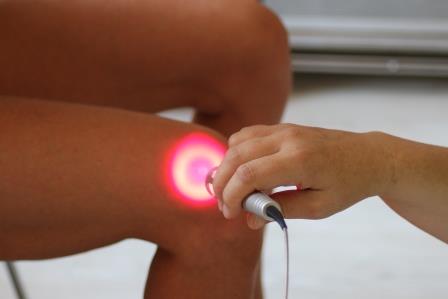Laser Center with soft laser or low level laser therapy (LLLT) and photodynamic therapy (PDT)
In contrast to the so-called "radical" hard lasers known already from the surgery, the softlaser are suitable for other fields of application: you work with lower capacities from 5-100 mW. Different penetration depth and characteristic effects can be achieved through the combined use of red, infrared, green, blue and yellow lasers.
The low level laser therapy is a new powerful therapy approach
Lasers are established as non-contact "light scalpels" for many years in the ophthalmology and surgical subjects of medicine. They be successfully used in aesthetic medicine for improving skin. Special advantage of this laser: with combined laser beams of higher performance (so-called class 4 lasers) tiny or poorly accessible tissue without greater blood loss can be cut, sealed or removed.
The laser medicine makes great strides: so to found new applications for laser with lower power. This is the amazing ability of the laser to their advantage, that the natural metabolism of the cells can be directly positively influenced by weak, low-energy laser light (so called low level laser therapy or LLLT). Latest research findings identified specific molecules (so-called photo acceptors) that with the photons of laser light, record and pass on the photon energy to the cell. This photo acceptors are the "power plants" of the cell of the mitochondrial respiratory chain. The laser light impinges on these mitochondria, its energy production is significantly increased. This is useful especially for fabrics with a naturally high energy demand such as retinal, neural tissue, muscles and immune system.
For whom or which diseases should the low level laser therapy be used?
The LLLT can be used successfully for all diseases, where an acute or chronic energy deficiency should be compensated. It applies especially to the so-called degenerative diseases. These include macular degeneration and other eye diseases, dementia, Parkinson's, Multiple sclerosis and other neuro-degenerative diseases, and chronic fatigue. The LLLT reduces pain in neck and lumbar spine problems, but also in other chronic pain syndromes. Even when chronic inflammation without bacterial cause the LLLT of part of a modern concept of laser medical treatment may be: rheumatism of the joints or connective tissue, she can regulate the inflammatory activity. In viral infections such as herpes -, hepatitis and HIV infections, she can strengthen the defense.
The regenerative medicine has already discovered the benefits of LLLT. Accelerates the healing of pressure ulcers and chronic ulcers (ulcers), but also other wounds. Athletes use the LLLT to shortening and improving the recoveries after intensive training or competition and treat sports injuries or consequential harm caused by sport.
How is the treatment using low level laser therapy?
The LLLT is usually performed as therapy series of 10-15 treatments (2-3 x per week) with a duration of 10-60 min. The weak laser light can be administered intravenously through the skin from the outside as well as a small Venenverweilkanüle (butterfly).
Important: the LLLT is painless and free of side effects. Venous laser therapy, some patients describe a feeling of warmth and relaxation, even joy (boost serotonin levels).
Photodynamic therapy is the latest "weapon" in combating cancer, chemo- and cancers are radiotherapy Oncology standard procedure for treating malignant tissue. They have however severe side effects and weaken the immune system of the affected people. In turn this can negatively affect the long-term prognosis of the disease. The research therefore looking for new ways of combating cancer, which does not have these disadvantages.
Photodynamic laser therapy (PDT) of tumors is an alternative that is offered only by very few centres in Germany. The lasers, which are used for this, are stronger than LLLT lasers, but weaker than the surgical laser cutting. PDT lasers, tumor tissue are irradiated directly, to enable a natural dye that has been enriched in tumor tissue. When the dye under release of oxygen radicals which destroy the tumor tissue disintegrates. Thus, the dye becomes gunpoint only locally in the tumor tissue, without the side effects that we know of a chemo - or radiation therapy! Another advantage of PDT is the fact that the immune system of the affected people is not weakened and to fight cancer used with. To make the most of this advantage, we combine with other procedures) the PDT, that support the immune system: naturopathic medicines, orthomolecular supplementation, heavy metal rejectors, hyperthermia. Immune stimulation and PDT can reach, that even cancer in advanced stages is detected and successfully fought back by the immune system.
Latest Infrared Laser Technology for joints, scars, mucous membranes and nails



Intravenous laser-light application (laser blood therapy) and Photodynamic therapy in the abdomen for tumor disease
Latest infrared laser technology for joints, scars, mucous membranes and nails
The latest generation of our new infrared laser is the world's first laser with 15 Watt CW, 4 wavelengths, 20 Watt intensive Super pulse technology and only had its world premiere in the summer of 2012.
Dynamically refined therapy
Our new infrared laser is a synonym for modern physical therapy and offers a wide range of treatment options.
Orthopaedic complaints stand in the foreground:
- Knee, shoulder and hip,
- Spinal conditions,
- Scars can be treated equally: pale down significantly and lose their Wulstigkeit be back movable on the lower fabric. Thus, they can lose also their property as a field again. Especially caesarean section scar can impair as interference fields the entire field of belly up to the digestive activity.
Other areas of use are:
- Dental and mouth area treatments such as Strahlenmukositis or Leukoplakia.
- Nail fungus and foot wart treatments.
The intense super pulse technology (ISP mode) with 1 Hz to 20,000 Hz allows to keep very low overheating of the skin surface and deeper to bring the energy.
